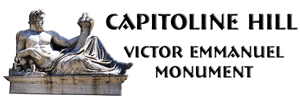
|
Monday, May 2, 2005
Pictures were taken by Gertrude Meyer.
|
The Campidoglio
Steps of Cordonata di Michelangelo
Michelangelo Buonarroti spent a great deal of his professional life in Rome working for the Pope. In addition to sculptures done in marble — his favorite medium — the Pope insisted that he paint the ceiling of the Sistine Chapel at the Vatican, which he didn't want to do, and to become an architect. According to biographers, he didn't want to do that either. Among his architectual endeavors was this stairway flanked at the top by sculptures Castor and Pollux, twin sons of Leda and Jupiter.
Palazzo Senatorio
Now housing the offices of the mayor,
this building was used by the Roman Senate from about the 12th century.
Michelangelo designed both the geometric paving which has a many-pointed sunburst at the center and the facade of this and the other buildings facing the Piazza del Campidoglio.
The back of this building overlooks the Forum Romanum.
See pictures of it on page 26. It is labeled The Tabularium.
Ernst Meyer poses beside statue of Marcus Aurelius.
At the center of the elliptical pavement of the Campidoglio, designed by Michelangelo but not finished until the 20th century, you’ll find this incredible equestrian gilded bronze status of Marcus Aurelius – one of the great emperors of Rome. He reigned from 161-180; a decent general, a good ruler, and an intelligent man, given to philosophy.
This sculpture was found in the Tiber River, and apparently the only reason it survived and wasn’t melted down to make a church door was because it was assumed to be Constantine, the first Christian Emperer. The sculpture in the piazza is actually a copy. The restored original, dating from the 2nd century AD, after suffering through many years or Roman pollution and pigeon droppings, is behind glass in the Palazzo Nuovo of the Musei Capitolini in this complex.
Click any image above to go to the next page, or use the navigation buttons below.
|